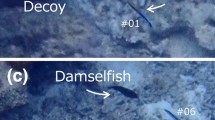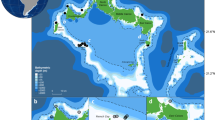Abstract
The results of an analysis of 16 laboratory records of Torpedo marmorata Risso attacks are presented: when a fish swims near a T. marmorata at rest, the latter jumps and simultaneously immobilizes the prey by its electric organ discharge (EOD). A water stream is used to direct the paralysed prey beneath its disc before swallowing. The attack is made if the prey swims at short distance (≤ 4 cm); height and direction of the jump are related to the position of the prey. The EOD, interrupted during the jump, reappears when the prey moves under the disc of T. marmorata, and ceases before swallowing. The strength of the EOD is sufficient to break the vertebral column of the prey. The possible receptor organs involved in this behaviour are presumed to be lateral line organs and touch detectors: the former to localize the prey before the jump, the latter to detect it under the disc. Evolutionary convergence of the prey capture behaviour of Torpedo, Malapterurus, and Electrophorus is also discussed.
Similar content being viewed by others
Literature Cited
Bauer, R.: Untersuchungen zur Entladungstätigkeit und zum Beutefangverhalten des Zitterwelses Malapterurus electricus Gemlin 1789 (Siluroidea, Malapteruridae Lacep. 1803). Z. vergl. Physiol. 59, 371–402 (1968).
— La décharge électrique pendant le comportement alimentaire de Electrophorus electricus. J. Physiol., Paris 62, 341–342 (1970).
Belbenoit, P.: Comportement alimentaire et décharge électrique associée chez Torpedo marmorata (Selachii, Pisces). Z. vergl. Physiol. 67, 205–216 (1970).
— et P. Moller: Relations entre la taille de la Torpille (Torpedo marmorata) et les caractéristiques de sa décharge alimentaire. J. Physiol., Paris 62, 121–122 (1970).
Dijkgraaf, S. und A. J. Kalmijn: Versuche zur biologischen Bedeutung der Lorenzinischen Ampullen bei den Elasmobranchiern. Z. verg. Physiol. 53, 187–194 (1966).
Schwartz, E.: Bau und Funktion der Seitenlinie des Streifenhechtlings (Aplocheilus lineatus Cuv. u. Val.). Z. vergl. Physiol. 50, 55–87 (1965).
— and A. D. Hasler: Perception of surface waves by the blackstripe topminnow Fundulus notatus. J. Fish. Res. Bd Can. 23, 1331–1352 (1966).
Szabo, T.: Ultrastructural evidence for mechanoreceptor function of the ampullae of Lorenzini. J. Microsc. 14, 343–350 (1972).
Wilson, D.: Notes from the Plymouth Aquarium II. J. mar. Biol. Ass. U. K. 32, 199–208 (1953).
Author information
Authors and Affiliations
Additional information
Communicated by J. M. Peres, Marseille
Supported by Research Grant No. 659440 from the Direction de Recherches et Moyens d'Essais (D.R.M.E.) to Dr. T. Szabo.
Dr. Bauer's stay in France was sponsored by a N.A.T.O. and a D.F.G. research fellowship.
Rights and permissions
About this article
Cite this article
Belbenoit, P., Bauer, R. Video recordings of prey capture behaviour and associated electric organ discharge of Torpedo marmorata (Chondrichthyes). Marine Biology 17, 93–99 (1972). https://doi.org/10.1007/BF00347299
Accepted:
Issue Date:
DOI: https://doi.org/10.1007/BF00347299




